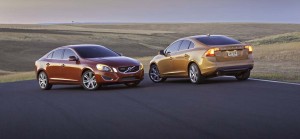
The Volvo S60 is one of seven cars to earn a "Superior" rating in the new test of collision avoidance systems.
While you’ll have to wait until at least the end of the decade before the first autonomous cars come to market, a large number of 2014 models are already being equipped with technologies designed to help motorists avoid impending collisions – or at least reduce the chance of death or injury if one occurs.
They go by a variety of different names, from Volvo’s City Safety to the Mercedes-Benz Distronic Plus, and all use cameras, laser, radar or sonar sensors to key on eye on traffic ahead – some systems even able to react to pedestrians and large animals. And since they don’t blink and won’t get distracted by an incoming phone call or kids in the back seat, these collision avoidance systems often can react faster than a motorist can to a potential problem.
But which are the best? That’s what the folks at the Insurance Institute for Highway Safety set out to determine. The IIHS is best known for its crash testing, issuing its own ratings and often stepping out ahead of federal regulators with new test standards. This time, however, the industry trade group wanted to know what systems were, indeed, most effective at avoiding those crashes.
And the IIHS says it found seven models that proved particularly effective at avoiding – or at least reducing the effects of – a frontal collision.
With so many new vehicles offering the technology, the first round of testing focused on what was described as “moderately priced and luxury midsize midsize cars and SUVs.” In other words, vehicles within the reach of perhaps the largest segment of new vehicle buyers. Seven models rated “superior,” according to the safety institute:
*Cadillac landed two models on the list, the new ATS sedan and the SRX crossover-utility vehicle;
*Mercedes-Benz scored a superior rating with the C-Class sedan;
* Also with two top-rated models was Subaru, with the Legacy sedan and Outback wagon; and
* Volvo rounded out the list with both its S60 sedan and XC60 crossover.
Another six of the 74 different models the IIHS tested went on to earn an advanced rating: the 2014 version of the Acura MDX crossover, the Audi A4 sedan and Q5 SUV, the 2014 Jeep Grand Cherokee SUV, the Lexus ES sedan and the 2014 Mazda6.
(Hi-tech safety features are rapidly migrating from luxury to mainstream vehicles. Click Here for the story.)
In many cases, the technology the IIHS rated comes as an option, rather than standard equipment, and some models offer different levels of collision avoidance. For example, the two Volvo models rated “superior” featured the optional Collision Warning with Full Auto Brake and Pedestrian Detection. But even Volvo’s standard-issue collision avoidance system was enough to earn the XC60 and S60 models an “advanced” rating.
To be ranked superior, a vehicle must be capable of automatically slowing down at both city and highway speeds. That requires front sensors that can watch out for traffic – and, in some cases, for pedestrians – and a braking system that can automatically be triggered if the driver doesn’t respond to a warning quickly enough.
“Front crash prevention systems can add a thousand dollars or more to the cost of a new car,” notes David Zuby, IIHS chief research officer,” but, “Our new ratings let consumers know which systems offer the most promise for the extra expense.”
(2014 Mercedes-Benz S-Class uses “sensor fusion” to reduce risk of collisions. Click Herefor a closer look.)
The IIHS developed a three-tier rating system for the new collision avoidance technology and the group says that even those that fall into the “basic” category “can provide significant benefits.” In fact, separate insurance industry studies have found that there has been a sharp reduction in the number and severity of collisions involving many of the higher-rated models, such as the Volvos, tested by the IIHS.
Collision avoidance technologies come in a variety of flavors. Some, the IIHS noted, simply warn the driver of an impending collision. They may begin to brake but won’t bring the vehicle to a complete stop. Some systems work only at relatively slow, city street speeds while others are designed for highway driving. Still others can bring a vehicle to a complete stop and, in some models will automatically start driving again when the obstacle ahead moves out of the way.
Such technologies are expected to prove critical to the planned development of fully autonomous automobiles which several makers now promise to begin offering by decade’s end.
(Nissan promises to put an autonomous vehicle into production in 2020. Click Here for more.)

